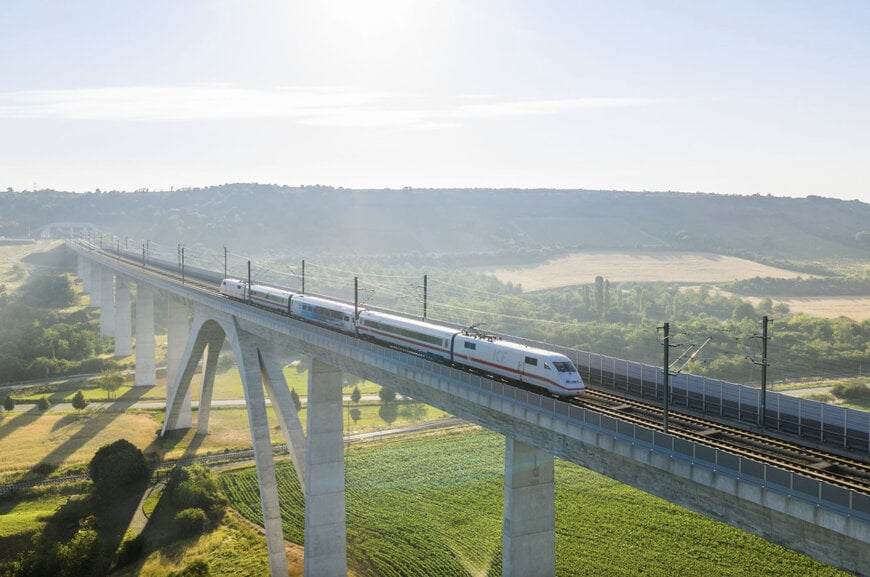railway-international.com
04
'25
Written on Modified on
ICE Test Train Reaches 405.0 km/h and Gathers Key Insights for High-Speed Rail
Deutsche Bahn and Siemens reached 405 km/h with ICE-S test train on Erfurt–Leipzig line, validating infrastructure, testing Velaro Novo performance, and collecting high-speed rail optimization data.
www.siemens.com

Deutsche Bahn (DB) and Siemens Mobility have reached a speed of 405.0 km/h with an ICE test train on the high-speed route between Erfurt and Leipzig/Halle. Train runs at speeds above 300 km/h are extremely rare on the German rail network and are conducted exclusively for testing purposes.
Dr. Philipp Nagl, CEO of DB InfraGO AG: “Today, an ICE has traveled faster than ever before on the Erfurt–Leipzig/Halle line. A new top speed of 405.0 km/h also confirms the high performance of the infrastructure on this high-speed route: after ten years of continuous operation, we can run at such high speeds without any modifications. It proves that infrastructure investments lay the foundation for reliable, sustainable, and high-capacity mobility and logistics across generations. The test runs are providing us with crucial data for the refurbishment and maintenance of high-speed routes as well as for the technical development of high-speed trains, which ultimately benefits our passengers.”
Christian Hirte, Parliamentary State Secretary at the Federal Minister for Transport: “Germany is and can be top! Today’s top-speed run shows that we in Germany have high-quality infrastructure and a powerful industry. The test results obtained will be of great value for DB AG in future procurements and beneficial to customers, helping them reach their destinations quickly, safely and punctually. This high-speed run also strengthens Germany’s position as an economic and export nation.”
Thomas Graetz, Vice President High Speed and Intercity Trains, Siemens Mobility: “The successful test runs of our Velaro Novo test vehicle, which today reached a speed of 405.0 km/h as part of the ICE-S, clearly demonstrate the performance capabilities of our latest generation of high-speed trains. Our goal was to gain deep insights into acoustics, aerodynamics and ride behavior at extreme speeds – and we achieved that today thanks to excellent collaboration with DB InfraGO AG and DB Systemtechnik. The Velaro Novo will revolutionize rail technology by setting new standards for capacity, efficiency and cost-effectiveness. Innovations like this are key to sustainable and future-oriented mobility.”
Dr. Hiie-Mai Unger, Chairwoman of the Management Board of DB Systemtechnik: “Driving innovation forward and preparing rail transport for the future – that’s what we at DB Systemtechnik contribute to with our test runs. With our high-speed measurement train, the ‘ICE-S’, we were able to gather many important findings today on acoustics, aerodynamics, ride behavior and the interaction between train and track at very high speeds. These findings support further route refurbishment and help us optimize rail operations – especially high-speed rail.”
The ICE-S from DB Systemtechnik is primarily used for test and measurement runs. It is used to test new lines, inspect infrastructure and carry out various high-speed tests. To precisely analyze and optimize operating conditions on high-speed routes, it is equipped with extensive measurement technology. This makes the ICE-S an essential component in the continued development and assurance of performance in the German high-speed rail network.
The new Velaro Novo from Siemens Mobility is the consistent further development of three previous Velaro generations. Numerous detailed innovations make this high-speed train a highly efficient vehicle, consuming up to 30 percent less energy while significantly reducing investment and maintenance costs. At the same time, seating capacity has been increased by ten percent. Thanks to a wide range of configuration options, the Velaro Novo is future-proof and can still be flexibly adapted to new requirements of operators even after years in service. The Velaro Novo test vehicle, named #seeitnovo, has been undergoing testing as part of the ICE-S for several years on the German long-distance rail network.
In regular service, Germany’s fast ICE trains run at speeds of up to 300 km/h. These speeds are achieved on specially designated high-speed lines, such as those between Berlin and Munich or Cologne and Frankfurt. These routes are specially constructed to ensure safe operation at high speeds.
The Erfurt–Leipzig/Halle route, part of German Unity Transport Project No. 8 (VDE 8), entered service in 2015 and is designed for high-speed travel. Before the test runs, the line underwent a comprehensive inspection by experts and remains in excellent condition. It is currently closed until 12 July for maintenance and optimization. Among other work, particularly low-maintenance bridge bearings are being installed to ensure that the infrastructure on this high-speed line remains reliable and high-performing. Train traffic is being rerouted to the parallel line during the closure. These diversions are included in the published timetables.
www.siemens.com

